Is Greenland’s Ice Disappearing?
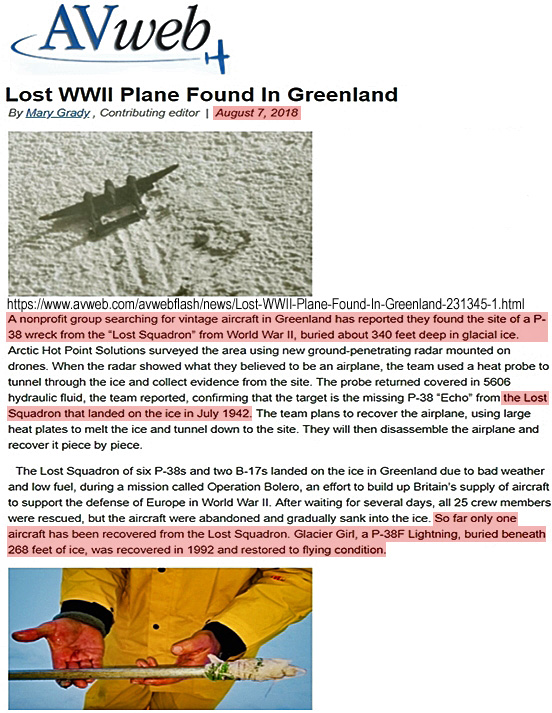
Image Source: AVweb, August 2018
I. Emergency Landing In 1942
In July, 1942, a squadron of six U.S. P-38 fighter planes and two B-17 bombers embarked on a flight mission to England when they were suddenly bombarded by severe weather.
All 8 planes were consequently forced to emergency-land on the southeastern corner of the Greenland ice sheet, about 29 kilometers from the coastal edge.
While all 25 of the occupants were ultimately rescued, the 8 planes had to be abandoned atop the surface of Greenland as it existed in 1942. Eventually the planes were buried beneath decades of ice and snow accumulation.
II. The first “Lost Squadron” plane rescued in 1992…buried under 268 feet of ice
Over the course of the next several decades, nostalgic interest in a search-and-recovery effort grew. After all, the Lost Squadron planes were effectively new when they were abandoned and, if preserved well enough, they could potentially be restored to flying condition .
The first several attempts to locate the planes during the 1980s were unsuccessful, as the search crews had underestimated how deep beneath the surface the planes were after 40-plus years of ice sheet growth. It ultimately took 12 tries before the first plane was spotted.
In 1988 the search crews were finally able to pinpoint the location of a P-38 that was ultimately named “Glacier Girl”. She was buried 260 feet (79.2 meters) below the surface of the ice sheet as it existed in 1988.
By 1992 the 260-foot depth had grown to 268 feet (81.7 meters), and “Glacier Girl” was slowly (piece-by-piece) retrieved from the ice.
III. Another Lost Squadron plane was found in mid-2018…buried under 340 feet of ice
Accompanied by far less fanfare, another Lost Squadron P-38 was located in 2018 using drone technology.
This plane was found buried under another 72 feet – 21.9 meters – of ice relative to the 1992 recovery site for the first P-38 rescue (340 feet versus 268 feet).
IV. Potential implications and Greenland observations
• Greenland’s interior ice is melting more slowly now than 95% of the last 9,000 years
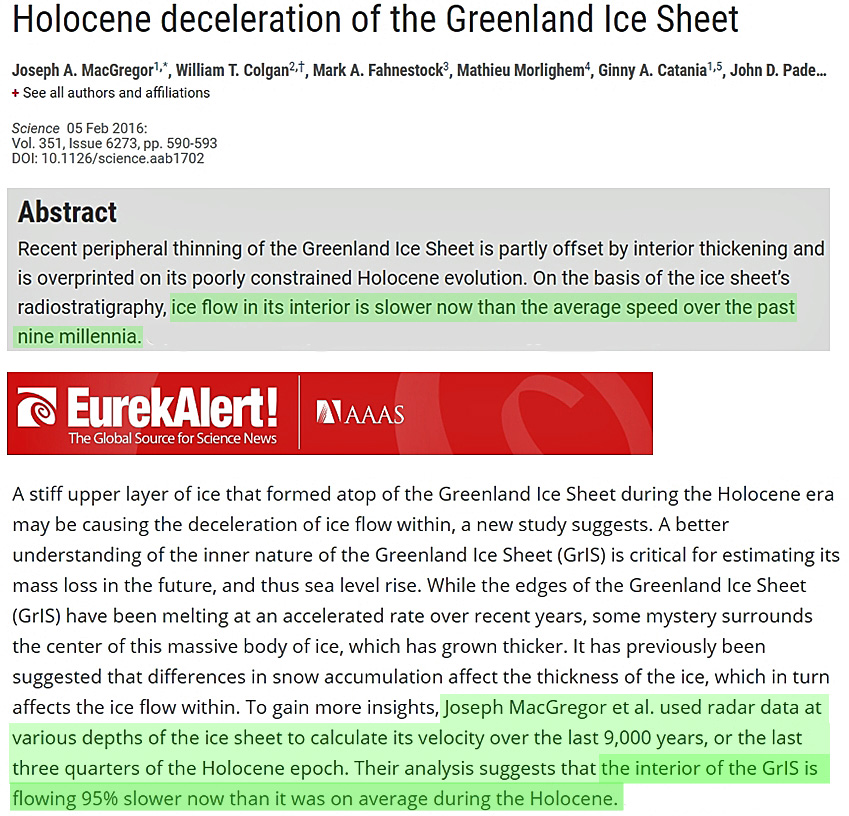
Image Source: MacGregor et al., 2016 and AAAS press release
• An anthropogenic influence on Greenland’s ice melt is too small to be detected

Image Source: Haine, 2016
• The Greenland Ice Sheet surface area is larger now than 95% of the last 8,000 years
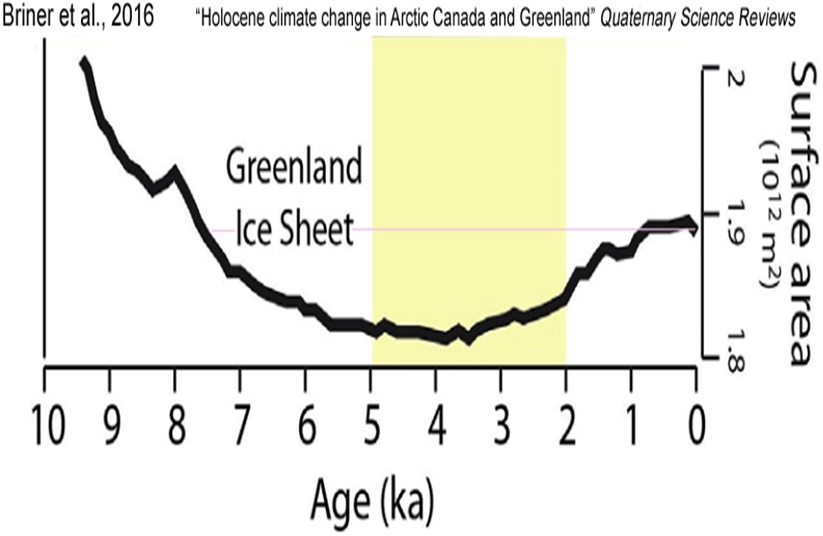
Image Source: Briner et al., 2016
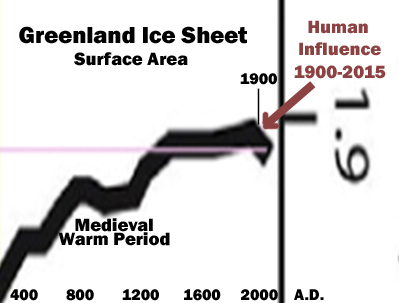
• Greenland hasn’t warmed overall since the 1920s and 1930s
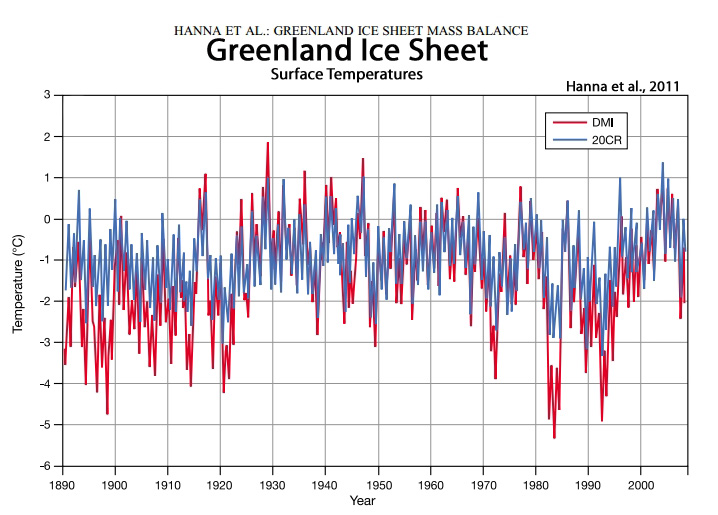
Image Source: Hanna et al., 2011
“The annual whole [Greenland] ice sheet 1919–32 warming trend is 33% greater in magnitude than the 1994–2007 warming.” (Box et al., 2009)
• Greenland ice melt has added just 1.5 cm to sea levels since 1900 – with no contribution during 1940-2000
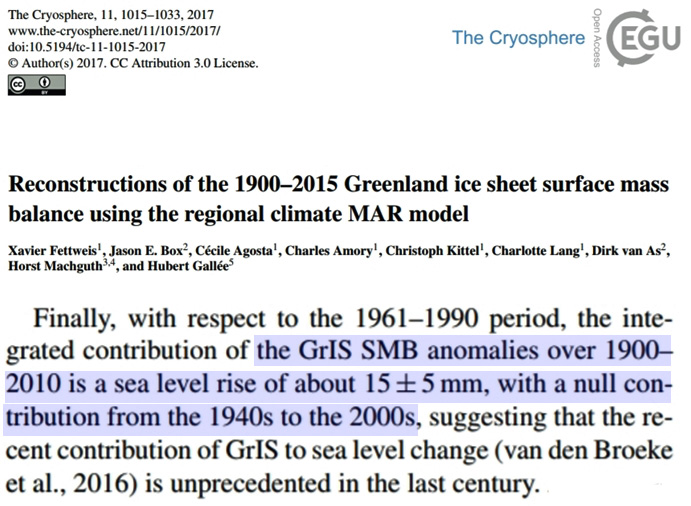
Image Source: Fettweis et al ., 2017
• Greenland has been cooling during the last decade
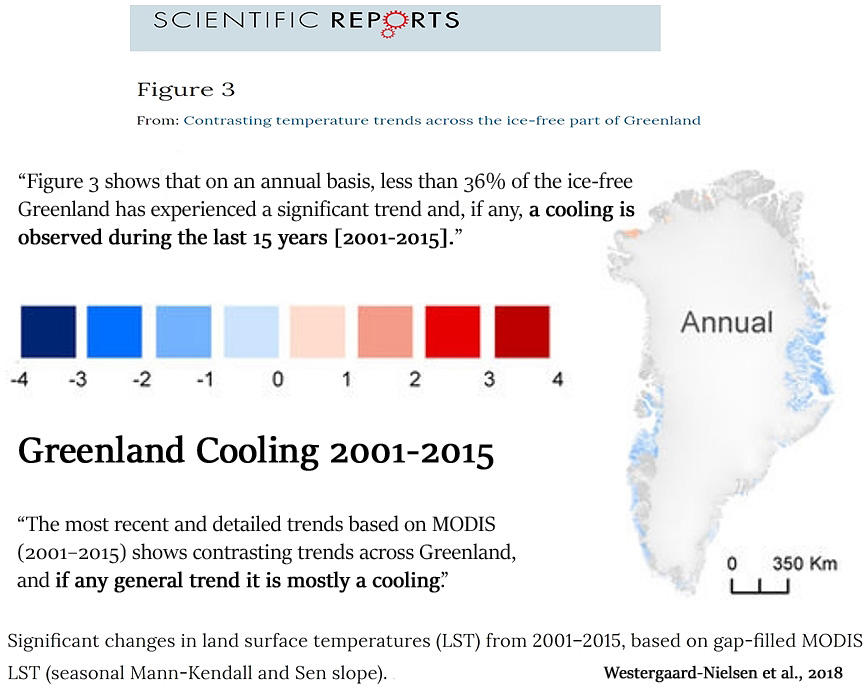
“Here we quantify trends in satellite-derived land surface temperatures and modelled air temperatures, validated against observations, across the entire ice-free Greenland. … Warming trends observed from 1986–2016 across the ice-free Greenland is mainly related to warming in the 1990’s. The most recent and detailed trends based on MODIS (2001–2015) shows contrasting trends across Greenland, and if any general trend it is mostly a cooling. The MODIS dataset provides a unique detailed picture of spatiotemporally distributed changes during the last 15 years. … Figure 3 shows that on an annual basis, less than 36% of the ice-free Greenland has experienced a significant trend and, if any, a cooling is observed during the last 15 years (<0.15 °C change per year).” (Westergaard-Nielsen et al., 2018)
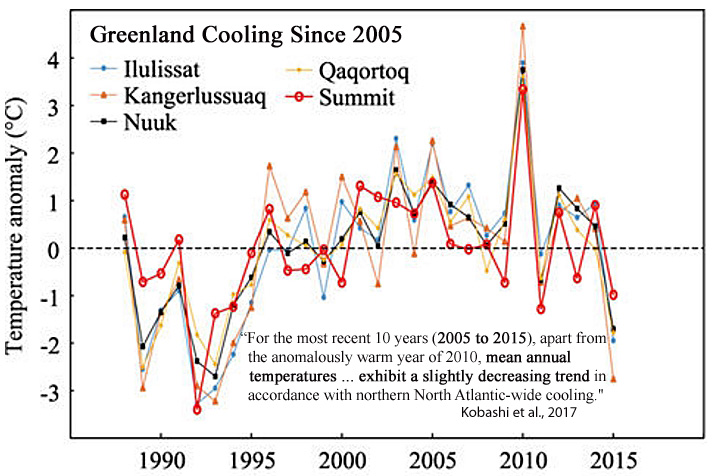
“For the most recent 10 years (2005 to 2015), apart from the anomalously warm year of 2010, mean annual temperatures at the Summit exhibit a slightly decreasing trend in accordance with northern North Atlantic-wide cooling. The Summit temperatures are well correlated with southwest coastal records (Ilulissat, Kangerlussuaq, Nuuk, and Qaqortoq).” (Kobashi et al., 2017)
• Greenland was much warmer than today throughout most of the last 10,000 years
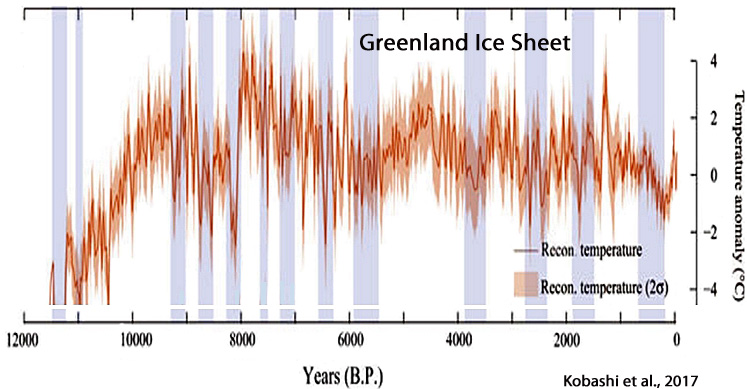
Image Source: Kobashi et al., 2017
“Greenland temperature reached the Holocene thermal maximum with the warmest decades occurring during the Holocene (2.9 °C warmer than the recent decades) at 7960 ± 30 years B.P.” (Kobashi et al., 2017)
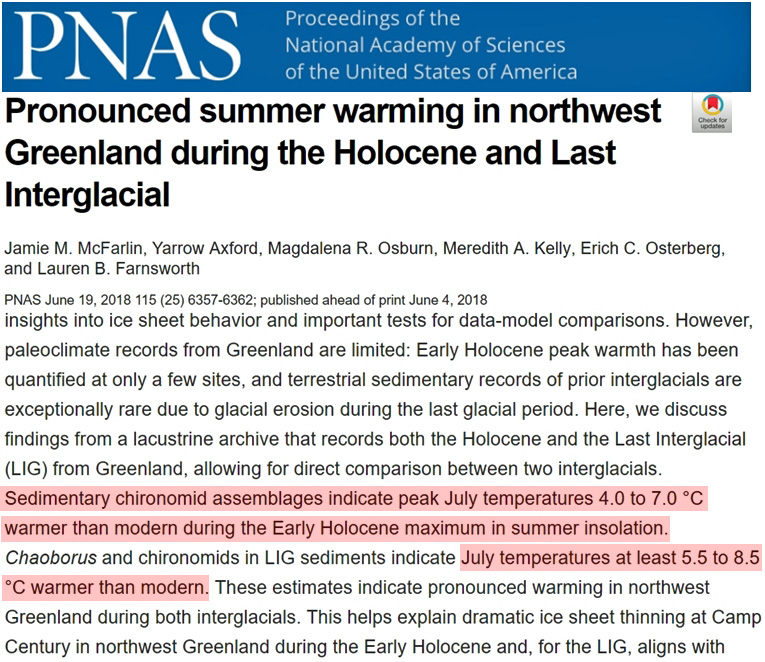





From the nature geoscience link:
Right after writing that…
“The anthropogenic melt from the Greenland ice
sheet is still too small to be detected(4,8)”
they wrote…
“And despite large changes in the freshwater budget
of the Arctic, some of which are anthropogenic(10), there
is no clear change…due to human climate forcing.”
I don’t know what is in ref.10, but whatever it is I’d
like to know where ELSE that “anthropogenic” fresh water
could possibly have come from, if not Greenland.
Perhaps in order to get published they had to cite a warmist
paper, and appear to be puzzled by why they themselves
couldn’t detect the dreaded human caused melting?
A little more on “Glacier Girl.”
https://arkencounter.com/blog/2015/10/30/airplanes-under-ice/
https://worldwarwings.com/rare-pictures-glacier-girl-excavated-250-feet-ice/
The picture in the Avweb article is of a B-17, not a P-38.
“On November 5, 1942, a US cargo plane slammed into the Greenland Ice Cap. Four days later, the B-17 assigned to the search-and-rescue mission became lost in a blinding storm and also crashed. Miraculously, all nine men on board survived, and the US military launched a daring rescue operation. But after picking up one man, the Grumman Duck amphibious plane flew into a severe storm and vanished.
Frozen in Time tells the story of these crashes and the fate of the survivors, bringing vividly to life their battle to endure 148 days of the brutal Arctic winter, until an expedition headed by famed Arctic explorer Bernt Balchen brought them to safety. Mitchell Zuckoff takes the reader deep into the most hostile environment on earth, through hurricane-force winds, vicious blizzards, and subzero temperatures.
Moving forward to today, he recounts the efforts of the Coast Guard and North South Polar Inc. – led by indefatigable dreamer Lou Sapienza – who worked for years to solve the mystery of the Duck’s last flight and recover the remains of its crew.”
They are attempting to use the drone to find the duck aircraft but they are located in a crevice field. More at bottom of second lint:
https://www.amazon.ca/Frozen-Time-Survival-Modern-Heroes-ebook/dp/B009NG2G54
https://www.livescience.com/63423-lost-squadron-unearthed-greenland-glacier.html
@ES
Not sure what you’re referring to, ES, but the photo at the top of the page from AVweb is a P-38. There’s no mistaking the dual bean fuselage, each with an engine, and the rear wing spanning them.
Here’s a B-17 for comparison. It has a single fuselage and 4 engines on the forward wing.
Also, here’s the AVweb article, and it is about the P-38 (same photo that Kenneth Richard posted above).
https://www.avweb.com/avwebflash/news/Lost-WWII-Plane-Found-In-Greenland-231345-1.html
Thanks for the other information. Very interesting. Dangerous places, the earth’s poles. Hard to keep from laughing at those who think a few extra fractions of a percent of CO2 are going to in any way tame them, or make them worse.
“The picture in the Avweb article is of a B-17, not a P-38.”
Are you referring to the picture which is shown at the top of the post?
The aircraft shown on the ice is definitely a P-38 – a single-seat fighter with twin engines and a distinctive twin rudder.
https://upload.wikimedia.org/wikipedia/commons/8/89/P-38_over_california.jpg
The B-17 was a big four-engine heavy bomber but with a single rudder.
https://upload.wikimedia.org/wikipedia/commons/0/0b/B17_-_Chino_Airshow_2014_(framed).jpg
A condensed version of Frozen in Time is here:
https://www.historynet.com/seven-down-in-greenland.htm
Better photo of B-17.
Sorry, but I missed the out-of-place propeller on the first one. It must be someone’s model. I was just trying to get a good view of it from above, and so hadn’t noticed that discrepancy at first, and I ignored that little voice saying “there’s something odd about this one”.
How is the planet warming when a plane that lands on ice in the 40s is subsequently buried in +200 feet of ice 60 years later?
Well, Greenland cooled by about 1.5 C between the 1940s and 1990s before it began warming again during 1995-2007.
Given that, I’m still scratching my head to understand why the ice accumulated at nearly twice the rate during the first 50 years than during the last 26:
1942 to 1992 – 268 feet of ice: Rate = 5.36 feet/year
1992 to 2018 – 72 feet of ice: Rate = 2.77 feet/year
Does anyone have any ideas why this would be?
I was wondering the same thing, RegGuheert.
3 feet per year is still an astonishing amount of snowfall, close to forty feet of accumulating snow per year. But not as astonishing as the rate over the first 50 years.
Nice blog. Let the articles you link to speak for themselves. I like that.
“…close to forty feet of accumulating snow per year.” Slight typo, I’m guessing.
And with that you managed to overcome my resistance to comment again, Kenneth. I had this feeling while reading the first part of the article and now your comment confirms it … your argument that Greenland isn’t melting because things get buried in ice 😉
The correct answer to Derg’s question would have been: because snow/ice accumulates from the top and melting/runoffs happen at the coasts.
And since I’m here, you posted this picture in the article: https://notrickszone.com/wp-content/uploads/2019/02/Holocene-Cooling-Greenland-Ice-Sheet-Briner-16-Anthropogenic-copy.jpg
Would you also conclude after let’s say one minute after putting an ice cube into warm water that that’s all that is ever going to happen to the ice cube? Or would you rather notice that warmer water (e.g. a warmer world) will continue to melt the ice until a new equilibrium is reached? The “human influence” as the image puts it will reach far into the century even if we manage to stop emitting GHGs today.
No, it’s melting alright. Staggering ice melt. So much so that a catastrophic 1.5 cm has been added to sea levels as meltwater equivalent during 1900-2010. Fortunately, there was no meltwater added to sea levels between 1940-2000, because apparently the ice accumulation and coastal melting were in balance. Whew!
Correct. But between 1940 and 2000 (I wrote 1940 and 1990), the ice mass buildup did not melt off the edges to sufficiently cause a negative mass balance. That probably has something to do with the conclusion that the interior of the ice sheet is melting more slowly today than it did for about 95% of the last 9,000 years.
.
That’s the Greenland ice sheet surface area. It shows that the ice sheet extent is larger now than it has been for about 95% of the last 8,000 years, with only the Little Ice Age slightly more extensive.
Right, nothing to see here. Everything is fine.
http://nsidc.org/greenland-today/files/2014/05/GrnToday_Fig7_16May.png
Indeed. The ice sheet growth even continued during 1992-2003. Agreed, not a big deal.
http://science.sciencemag.org/content/310/5750/1013
“A continuous data set of Greenland Ice Sheet altimeter height from European Remote Sensing satellites (ERS-1 and ERS-2), 1992 to 2003, has been analyzed. An increase of 6.4 ± 0.2 centimeters per year (cm/year) is found in the vast interior areas above 1500 meters, in contrast to previous reports of high-elevation balance. Below 1500 meters, the elevation-change rate is –2.0 ± 0.9 cm/year, in qualitative agreement with reported thinning in the ice-sheet margins. Averaged over the study area, the increase is 5.4 ± 0.2 cm/year, or ∼60 cm over 11 years, or ∼54 cm when corrected for isostatic uplift. Winter elevation changes are shown to be linked to the North Atlantic Oscillation.”
Can you do a comparison on the Antarctica ice sheet?
the original article is disingenuous in using a picture of an aircraft sitting on the ice. Most people just look at the headline and a picture and get the impression that the ice melted revealing an aircraft, instead of 200′ of ice on top since the ’40’s.
@joe
Looks like a photo of the plane shortly after it crashed, probably taken by the rescue party to document the event. Here’s a short news clip about the event.
https://youtu.be/fNEmGaAplgI
At that joe is the problem.
The vast majority of people pay more attention and imaginatively construct their own private fiction around a picture/story, rather than find out the actuality of the matter. That is why so many people are taken in by the cAGW (aka Climate Change™) nonsense. For them looking-up the last 500 to 1000 years of weather/climate events is just too much work.
So many people are not very curious but are quite willing to quote the news media of “scientists say…”. They resign all their critical thinking to the authority of the news media outlets. They are unwilling to actually look at which scientists or what they actually say, whether or not it’s probable or aligns with their life experiences.
And why would I waste my time on that sort of research? I’m a railway nerd, not a climate nerd. I leave it to the climate nerds to do that sort of stuff and assume they know what they are doing.
It’s when I find they’ve been “bought” by the eco-nerds and they’re lying to me that I get p***ed off and start to do my own research (as best I can). And I know they’re lying because eco-nerds always lie. It’s what they do best. And they are the ones that are calling the shots because, as ever, they are all plausible and “sciencey” and those people who aren’t nerds and have no reason to think ill of them assume they are honest and on the side of truth.
Which is why people skim-read articles like this and get it all ass-backwards.
I wonder how the eco-nerds manage to make everything sound plausible when it is so obviously wrong to you that you think they are lying to you. On the other hand climate-nerds that you likely think are telling the truth don’t sound plausible at all to the rest of us. I’d say the problem with this kind of perception is entirely in your domain to fix.
By – as tomOmason wrote – actually looking at the science, doing the research and not generally assuming that you are being lied to by anyone who says things are different than you imagine.
Also of note is that the ice melt in Greenland appears to be affected (if on controlled) by the Earth’s internal heat that enhances rapid ice flow and subglacial melting in Greenland.
The press release from The University of Montana says
Geothermal heat contributes to Greenland ice melt
And as reported here https://www.eurekalert.org/pub_releases/2016-04/tuom-ghc040616.php
I’m surprised nobody has tried to claim that the reason the plane was buried under so much ice is because the high temperatures made the ice all squishy so the plane sank into the ice.
What high temperatures? I hear you say. Well there must have been, or the plane wouldn’t have sunk!
(perfect circular logic).
[…] Read rest at No Tricks Zone […]
Also of note is this report from 2013, https://www.eurekalert.org/pub_releases/2013-12/uou-gis121913.php and called Greenland ice stores liquid water year-round
[my bold]
So in any one year the measured outflow of water from Greenland may have little to do with the perceived snow and ice melt.
Most of Greenland ice melted to bedrock in recent geologic past, says study
Ice comes and goes….
“Greenland melting has nothing to do with anthropogenic CO2” – Reality
“Oh, no! Our cause is lost.” – warmists
““If we lost [Greenland ice] in periods of natural forcing, we may lose it again.” – paleoclimatologist
“Now all we have to do is convince people they have to pay us to ‘do something’ about it, and our cause is saved. YAY!” – warmists
Because you know they will never give up. There will always be a crisis, real or imagined, that the UN con artists will try to use to their advantage at our expense.
So the Arctic region has been warming up, eh.
Now that’s happened before has it not…
As reported HERE —
or
This report HERE —
[…] Source […]